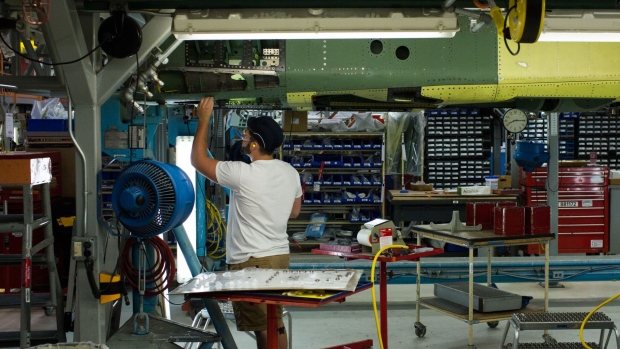Jun 3, 2024
US Factory Activity Contracts as Orders Slide, Output Weakens
, Bloomberg News

(Bloomberg) -- US factory activity shrank in May at a faster pace as output came close to stagnating and a measure of orders fell by the most in nearly two years.
The Institute for Supply Management’s manufacturing gauge fell 0.5 point to 48.7, the weakest in three months, data out Monday showed. Readings less than 50 indicate contraction. The figure was softer than the 49.5 median estimate in a Bloomberg survey of economists.
The purchasing managers group’s measure of new orders slid 3.7 points, the biggest drop since June 2022, to 45.4 in May. The bookings index now stands at the lowest level in a year, suggesting demand across the economy is weakening. As a result, ISM’s production index slipped to 50.2.
Seven industries reported contracting activity in May, led by wood products, plastics and rubber, and machinery. Seven sectors reported growth.
“Demand remains elusive as companies demonstrate an unwillingness to invest due to current monetary policy and other conditions,” Timothy Fiore, chair of the ISM Manufacturing Business Survey Committee, said in a statement. “These investments include supplier order commitments, inventory building and capital expenditures.”
The figures indicate US manufacturing is struggling to gain momentum due to high borrowing costs, restrained business investment in equipment and softer consumer spending. At the same time, producers are battling elevated input costs.
“I think we plateaued,” Fiore said on a call with reporters. “Without some kind of movement on the monetary side here, we’re probably sitting where we’re going to sit for quite some time.”
While the ISM’s index of prices paid for materials and other inputs eased to 57 last month, it’s still the second-highest in about two years. Twenty-six percent of companies reported higher prices in May, down from 31% a month earlier.
Select ISM Industry Comments
“Seems like a minor slowdown is happening. With less spending in the economy, less pressure on us for our products.” — Chemical Products
“Certain markets are soft, but others are ahead of forecast, allowing us to maintain overall. Concerns with the economy continue to drive business decisions.” — Transportation Equipment
“Volume continues to be challenging, mostly due to inflationary impacts.” — Food, Beverage & Tobacco Products
“Backlog is dwindling as we get caught up on orders; new orders are not coming in as robust as the backlog is going down. Inflation continues to be a problem with pricing of raw material and interest rates. We expect a flat rest of calendar year 2024, especially given that it’s a presidential election year.” — Machinery
“Export shipments continue to be soft as capital equipment sales remain lower than forecast. As a result, production is also trending lower and inventory that is not able to be pushed out is growing.” — Fabricated Metals
“Demand has been strong the first few months — ahead of budget, consistent with last year. Bookings are starting to slow down for May and June. “ — Electrical Equipment & Appliances
“Business is picking up, with incoming bookings increasing.” — Furniture
“General concern about overall industry economics. Pricing weakness continues, and we anticipate more headwinds in the coming months for spot orders and inflation. Contract order book remains steady.” — Primary Metals
One hopeful sign for domestic producers was a gauge of export demand grew for the third time in the last four months.
Another was a pickup in factory employment. The group’s measure climbed to 51.1 in May, the highest since August 2022 and suggesting producers are having more success securing labor.
--With assistance from Kristy Scheuble.
(Adds comment from ISM’s Fiore)
©2024 Bloomberg L.P.






